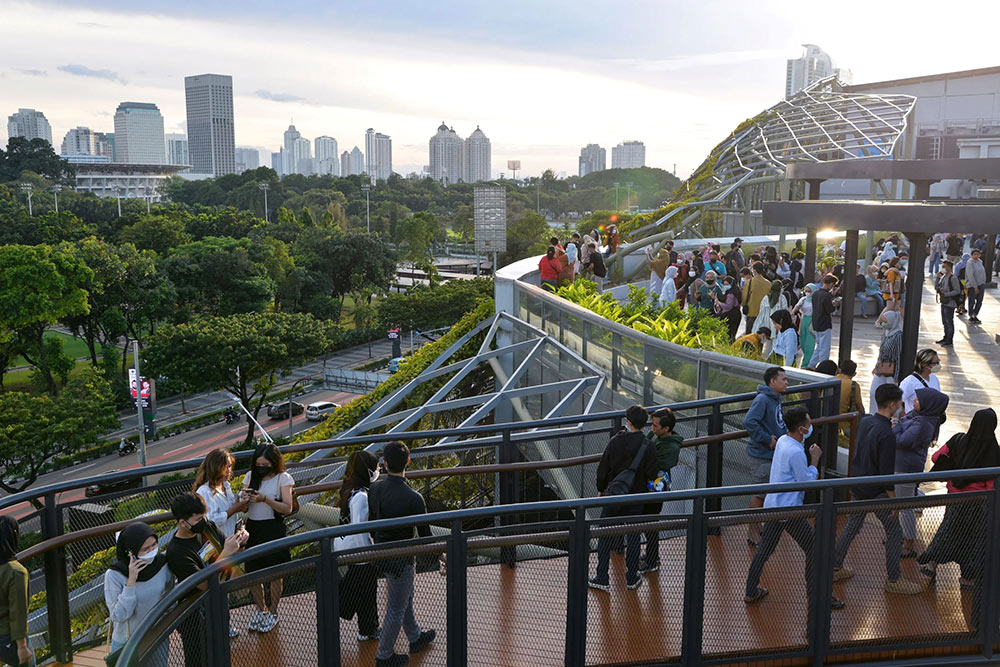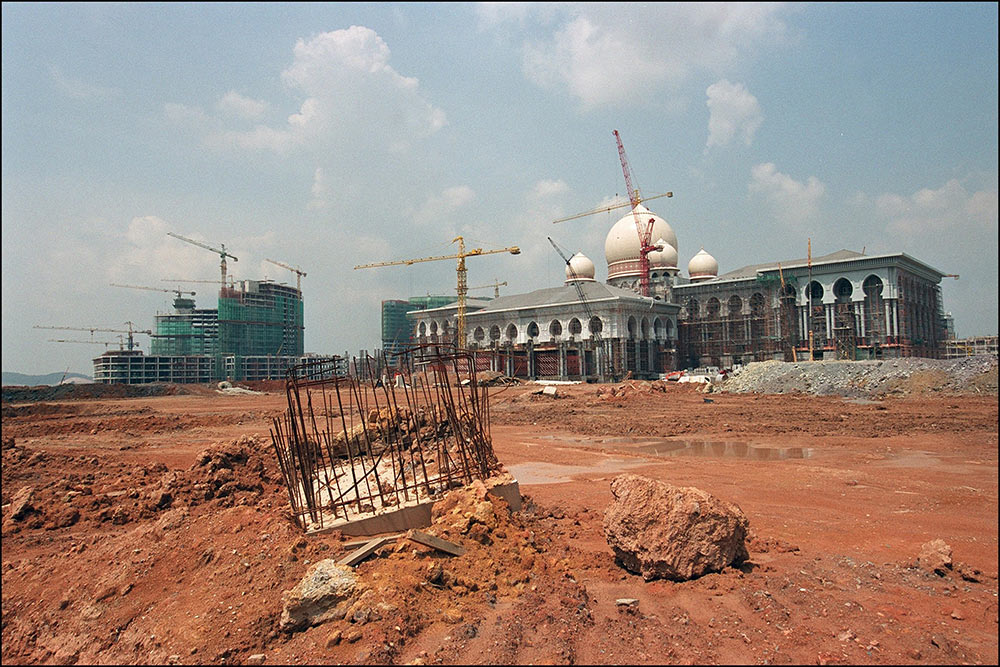
印度尼西亚的总统佐科·维多多在2019年公布了新首都建设计划,承诺打造一个清洁、绿色、高科技的乌托邦。新首都位于婆罗洲岛,将建成一座雨林都市,在热带雨林的覆盖下,有蜿蜒曲折的水道和设计大胆的现代建筑。流畅的高速交通系统方便居民在城市群之间穿梭,将促进教育、医疗和科技等高价值行业的创新。
印尼总统又称佐科威,在2014年当选。当时,他承诺将带领印尼经济转型,解决官僚主义和腐败问题,打造市场导向的现代化经济体系,通过建设一流的基础设施来提升印尼对外国投资者的吸引力。印尼的新首都被命名为“努桑塔拉”,将耗资325亿美元,是佐科威为印尼设想的伟大未来愿景的核心。
但这只是梦想,现实却更加复杂。在因为新冠疫情原因而长时间推迟表决之后,印尼议会在今年1月终于通过立法,将佐科威的新首都计划付诸实施。但新首都建设项目的推进十分不顺。反腐败活动人士指控政府贪污,而环保团体对新首都的环保性提出了质疑,认为这座城市最终将像现首都雅加达一样要消费大量的天然气。
投资者也不看好该项目。软银(Softbank)的创始人及首席执行官孙正义最初似乎有意参与该项目融资。他曾经表示将为印尼的新首都投资400亿美元。但在今年3月初,他正式放弃该计划,没有给出任何解释。新首都努桑塔拉没有成为印尼新经济的象征,反而受到了老问题的拖累。
印尼并非第一个建设新首都的国家。巴西在1960年将首都从里约热内卢迁到了专门新建的城市巴西利亚。10年后,尼日利亚从拉各斯迁都到阿布贾。过去20年,马来西亚、哈萨克斯坦和缅甸都有过迁都之举。几十年来,日本一直在讨论将中央政府部门搬出东京。
问题不在于建设一座新城市,而是如何说服人们迁移。巴西建设巴西利亚的本意是在沿海城市以外,鼓励内陆地区发展。但按照一名建筑师的说法,数十年来,巴西利亚依旧只是荒凉的“政府办公园区”,每到周末,无聊的居民都会涌入里约。缅甸庞大的新首都内比都的占地面积比美国的纽约市大六倍,但这里几乎无人居住。就连议员和政府官员也选择继续在仰光居住,通勤数百英里前往内比都开会。2000年,马来西亚做出一个明智的决定,将新首都布城定在距离原首都吉隆坡只有25英里的地方,使它更像是一个容纳行政职能的郊区。政府已经迁走,但人们不必随着一起迁移。

印尼无法学习马来西亚的做法;它只能将新首都建在更远的地方。因为有超过1000万人口的雅加达正在下沉。到2050年,地面下沉和海平面上升将导致雅加达的四分之一沉入水下。此外,雅加达所在的爪哇岛处在断层线上,极易发生地震、火山喷发和海啸。
位于雅加达的独立分析师凯文·奥鲁尔克说:“基本上,一场巨大灾难的阴影目前正在笼罩着这座城市。”新首都位于婆罗洲东加里曼丹省,距离雅加达超过600英里,相比之下更安全。如果雅加达出现最糟糕的情况,至少政府还能够保持正常运作。
此外,新首都还有经济和政治优势。爪哇岛是印尼群岛的17000个岛屿之一,但却贡献了印尼60%的GDP。佐科威希望新首都可以刺激其他地区的发展。他还希望转移国家政治中心。印尼作为一个庞大的岛国,有2.7亿人口,而相距遥远的地区之间一直存在政治分裂的风险。东加里曼丹基本处于印尼的中心,因此更适合作为一个团结的象征。
但如果说迁都有合理的理由,那么实际操作起来却困难重重。以能源为例。虽然佐科威一直宣传新首都保证环保,并计划使用水力发电厂发电,但这座基础设施完工却遥遥无期。至少在初期,新首都的电力供应将来自当地广泛使用的煤炭和天然气发电。新首都可能无法避免雅加达的污染问题,反而还会像雅加达一样需要消耗大量的化石燃料。雅加达的电力主要来自燃煤发电厂。奥鲁尔克称:“我认为新首都会产生大量排放,尤其是在前十年左右。”
如果新首都采用可再生能源,其电力就将来自位于北加里曼丹的卡延河水电站大坝,承建方是中国三峡大坝的建设单位。虽然新首都附近的景观已经被数十年的采矿和油棕榈种植破坏殆尽,但卡延河沿岸流域却是生态敏感区。奥鲁尔克表示:“在评估首都的环境影响时,我们不能只看城市的所在地。”
新首都的反对者对于该计划的正当性提出质疑。2019年,包括矿业倡导网络(Mining Advocacy Network)和趋势亚洲(Trend Asia)在内的非政府组织团体调查了新首都所在地的土地所有者。他们列出了一份印尼工业和政治精英名单。其中包括佐科威政府的国防部部长和前总统候选人普拉博沃·苏比安托以及他的兄弟和侄子。由印尼海洋事务部部长控股的一家公司也在当地拥有大量煤矿权益。
该项目的批评者担心寡头可能利用该项目谋取私利。绿色和平组织(Greenpeace)印尼办公室的阿里·龙帕斯说:“我们关心谁会从中获利。”龙帕斯表示,煤电和供水合同已经被判授给与政府关系密切的企业。普拉博沃的兄弟在2021年12月召开的新闻发布会上指出,他早在新首都的选址确定之前就已经在当地拥有土地,并称“中间没有任何政治交易。”
另外一个问题是城市治理方式。佐科威组建了一个名为首都城市管理局(Capital City Authority)的部门来管理努桑塔拉。批评者指责这种做法缺乏民主。印尼加查马达大学(Gadjah Mada University)的宪法专业讲师扬塞·亚利桑那说:“政府并不关心公众参与问题,这种态度从城市管理结构的设计中可见一斑。”印尼的其他省市均由民选省长和市长负责管理,但却没有一位民选官员来监督首都城市管理局的运行。亚利桑那表示:“地方社区无法提出它们关心的问题。中央政府似乎正在建设一座没有民主的首都城市。”
首都项目并不是佐科威独裁倾向的唯一例子。他在2014年当选总统前后判若两人。印尼作为东南亚人口最多、规模最大的经济体,经历过苏哈托将军30多年的独裁统治。1998年,苏哈托政府被推翻之后,在他执政期间暴富的寡头们继续把持国内政治和军队。佐科威与寡头们不同。佐科威出身基层,进入政界之前是一名家具制造商,以开放协作、有前瞻性思维的改革者闻名。
但他似乎逐渐将帮助他崛起的民主理想,视为推行经济议程的障碍。2020年,他推出了一揽子改革措施,旨在简化企业监管,为企业减负。这些法律更方便企业辞退员工和降低最低工资,而当时与新冠疫情相关的裁员潮对印尼人民造成了严重影响。有数以千计的民众走上街头抗议,结果被警方逮捕。政府还逮捕了持反对立场的政治家,取缔了调查腐败问题的部门。亚利桑那称:“这类政府让人不由想起新秩序。”所谓新秩序是指苏哈托的独裁统治。
努桑塔拉可能让佐科威再次违背民意。随着印尼逐渐从新冠疫情当中恢复,很少有人支持投入数百亿美元公帑建设新首都。能源成本的上涨让政府的预算更加捉襟见肘。但这些无法阻止佐科威,他已经加快了新首都的建设步伐(反对者有时将新首都称为“Jokowigrad”)。今年3月初,佐科威到现场参加了开工仪式。他希望在2024年第二个也是最后一个任期结束时,能够将多个政府部门和公务人员搬到新首都。马来西亚从吉隆坡迁都到布城,虽然规模较小,但依旧用了10多年才完成搬迁。
如果佐科威的计划无法成功,他似乎正在考虑一个巧妙的变通方法:他最亲密的政治盟友最近在接受采访时讨论了通过修宪让佐科威第三次连任以完成新首都计划的可能性。总统希望新首都成为印尼新形象的象征。但讽刺的是,这个项目却将印尼落后、腐败的治理方式暴露无遗。(财富中文网)
译者:刘进龙
审校:汪皓
印度尼西亚的总统佐科·维多多在2019年公布了新首都建设计划,承诺打造一个清洁、绿色、高科技的乌托邦。新首都位于婆罗洲岛,将建成一座雨林都市,在热带雨林的覆盖下,有蜿蜒曲折的水道和设计大胆的现代建筑。流畅的高速交通系统方便居民在城市群之间穿梭,将促进教育、医疗和科技等高价值行业的创新。
印尼总统又称佐科威,在2014年当选。当时,他承诺将带领印尼经济转型,解决官僚主义和腐败问题,打造市场导向的现代化经济体系,通过建设一流的基础设施来提升印尼对外国投资者的吸引力。印尼的新首都被命名为“努桑塔拉”,将耗资325亿美元,是佐科威为印尼设想的伟大未来愿景的核心。
但这只是梦想,现实却更加复杂。在因为新冠疫情原因而长时间推迟表决之后,印尼议会在今年1月终于通过立法,将佐科威的新首都计划付诸实施。但新首都建设项目的推进十分不顺。反腐败活动人士指控政府贪污,而环保团体对新首都的环保性提出了质疑,认为这座城市最终将像现首都雅加达一样要消费大量的天然气。
投资者也不看好该项目。软银(Softbank)的创始人及首席执行官孙正义最初似乎有意参与该项目融资。他曾经表示将为印尼的新首都投资400亿美元。但在今年3月初,他正式放弃该计划,没有给出任何解释。新首都努桑塔拉没有成为印尼新经济的象征,反而受到了老问题的拖累。
印尼并非第一个建设新首都的国家。巴西在1960年将首都从里约热内卢迁到了专门新建的城市巴西利亚。10年后,尼日利亚从拉各斯迁都到阿布贾。过去20年,马来西亚、哈萨克斯坦和缅甸都有过迁都之举。几十年来,日本一直在讨论将中央政府部门搬出东京。
问题不在于建设一座新城市,而是如何说服人们迁移。巴西建设巴西利亚的本意是在沿海城市以外,鼓励内陆地区发展。但按照一名建筑师的说法,数十年来,巴西利亚依旧只是荒凉的“政府办公园区”,每到周末,无聊的居民都会涌入里约。缅甸庞大的新首都内比都的占地面积比美国的纽约市大六倍,但这里几乎无人居住。就连议员和政府官员也选择继续在仰光居住,通勤数百英里前往内比都开会。2000年,马来西亚做出一个明智的决定,将新首都布城定在距离原首都吉隆坡只有25英里的地方,使它更像是一个容纳行政职能的郊区。政府已经迁走,但人们不必随着一起迁移。
印尼无法学习马来西亚的做法;它只能将新首都建在更远的地方。因为有超过1000万人口的雅加达正在下沉。到2050年,地面下沉和海平面上升将导致雅加达的四分之一沉入水下。此外,雅加达所在的爪哇岛处在断层线上,极易发生地震、火山喷发和海啸。
位于雅加达的独立分析师凯文·奥鲁尔克说:“基本上,一场巨大灾难的阴影目前正在笼罩着这座城市。”新首都位于婆罗洲东加里曼丹省,距离雅加达超过600英里,相比之下更安全。如果雅加达出现最糟糕的情况,至少政府还能够保持正常运作。
此外,新首都还有经济和政治优势。爪哇岛是印尼群岛的17000个岛屿之一,但却贡献了印尼60%的GDP。佐科威希望新首都可以刺激其他地区的发展。他还希望转移国家政治中心。印尼作为一个庞大的岛国,有2.7亿人口,而相距遥远的地区之间一直存在政治分裂的风险。东加里曼丹基本处于印尼的中心,因此更适合作为一个团结的象征。
但如果说迁都有合理的理由,那么实际操作起来却困难重重。以能源为例。虽然佐科威一直宣传新首都保证环保,并计划使用水力发电厂发电,但这座基础设施完工却遥遥无期。至少在初期,新首都的电力供应将来自当地广泛使用的煤炭和天然气发电。新首都可能无法避免雅加达的污染问题,反而还会像雅加达一样需要消耗大量的化石燃料。雅加达的电力主要来自燃煤发电厂。奥鲁尔克称:“我认为新首都会产生大量排放,尤其是在前十年左右。”
如果新首都采用可再生能源,其电力就将来自位于北加里曼丹的卡延河水电站大坝,承建方是中国三峡大坝的建设单位。虽然新首都附近的景观已经被数十年的采矿和油棕榈种植破坏殆尽,但卡延河沿岸流域却是生态敏感区。奥鲁尔克表示:“在评估首都的环境影响时,我们不能只看城市的所在地。”
新首都的反对者对于该计划的正当性提出质疑。2019年,包括矿业倡导网络(Mining Advocacy Network)和趋势亚洲(Trend Asia)在内的非政府组织团体调查了新首都所在地的土地所有者。他们列出了一份印尼工业和政治精英名单。其中包括佐科威政府的国防部部长和前总统候选人普拉博沃·苏比安托以及他的兄弟和侄子。由印尼海洋事务部部长控股的一家公司也在当地拥有大量煤矿权益。
该项目的批评者担心寡头可能利用该项目谋取私利。绿色和平组织(Greenpeace)印尼办公室的阿里·龙帕斯说:“我们关心谁会从中获利。”龙帕斯表示,煤电和供水合同已经被判授给与政府关系密切的企业。普拉博沃的兄弟在2021年12月召开的新闻发布会上指出,他早在新首都的选址确定之前就已经在当地拥有土地,并称“中间没有任何政治交易。”
另外一个问题是城市治理方式。佐科威组建了一个名为首都城市管理局(Capital City Authority)的部门来管理努桑塔拉。批评者指责这种做法缺乏民主。印尼加查马达大学(Gadjah Mada University)的宪法专业讲师扬塞·亚利桑那说:“政府并不关心公众参与问题,这种态度从城市管理结构的设计中可见一斑。”印尼的其他省市均由民选省长和市长负责管理,但却没有一位民选官员来监督首都城市管理局的运行。亚利桑那表示:“地方社区无法提出它们关心的问题。中央政府似乎正在建设一座没有民主的首都城市。”
首都项目并不是佐科威独裁倾向的唯一例子。他在2014年当选总统前后判若两人。印尼作为东南亚人口最多、规模最大的经济体,经历过苏哈托将军30多年的独裁统治。1998年,苏哈托政府被推翻之后,在他执政期间暴富的寡头们继续把持国内政治和军队。佐科威与寡头们不同。佐科威出身基层,进入政界之前是一名家具制造商,以开放协作、有前瞻性思维的改革者闻名。
但他似乎逐渐将帮助他崛起的民主理想,视为推行经济议程的障碍。2020年,他推出了一揽子改革措施,旨在简化企业监管,为企业减负。这些法律更方便企业辞退员工和降低最低工资,而当时与新冠疫情相关的裁员潮对印尼人民造成了严重影响。有数以千计的民众走上街头抗议,结果被警方逮捕。政府还逮捕了持反对立场的政治家,取缔了调查腐败问题的部门。亚利桑那称:“这类政府让人不由想起新秩序。”所谓新秩序是指苏哈托的独裁统治。
努桑塔拉可能让佐科威再次违背民意。随着印尼逐渐从新冠疫情当中恢复,很少有人支持投入数百亿美元公帑建设新首都。能源成本的上涨让政府的预算更加捉襟见肘。但这些无法阻止佐科威,他已经加快了新首都的建设步伐(反对者有时将新首都称为“Jokowigrad”)。今年3月初,佐科威到现场参加了开工仪式。他希望在2024年第二个也是最后一个任期结束时,能够将多个政府部门和公务人员搬到新首都。马来西亚从吉隆坡迁都到布城,虽然规模较小,但依旧用了10多年才完成搬迁。
如果佐科威的计划无法成功,他似乎正在考虑一个巧妙的变通方法:他最亲密的政治盟友最近在接受采访时讨论了通过修宪让佐科威第三次连任以完成新首都计划的可能性。总统希望新首都成为印尼新形象的象征。但讽刺的是,这个项目却将印尼落后、腐败的治理方式暴露无遗。(财富中文网)
译者:刘进龙
审校:汪皓
When Indonesian President Joko Widodo announced his plan to build a new capital city back in 2019, he promised a clean, green, high-tech Utopia. Located on the island of Borneo, the new capital would be a rainforest metropolis featuring meandering waterways and bold, contemporary architecture nestled under a tropical forest canopy. A sleek, high-speed transport system would whisk inhabitants between urban clusters organized to support innovation in high-value sectors like education, health and tech.
Jokowi, as the president is popularly known, was elected in 2014 on a promise to transform Indonesia’s economy, long hobbled by red tape and corruption, into a modern, market-oriented system with first-rate infrastructure sure to burnish the nation’s appeal to foreign investors. Nusantara, the name chosen for the new capital, was to be the gleaming, $32.5 billion centerpiece of Jokowi’s grand vision for Indonesia’s future.
That was the dream. The reality is more complicated. After a long COVID-related delay, the Indonesian parliament in January passed legislation to put Jokowi’s plan for Nusantara into action. But the project’s momentum is faltering. Anti-corruption campaigners have made allegations of graft against the government, and environmental groups have attacked the city’s green credentials, suggesting that the new capital may end up being just as gas-guzzling as the current one, Jakarta.
Investors, too, are bolting. Masayoshi Son, the founder and CEO of Softbank, was among those who initially seemed interested in funding the project. He had floated the idea of pumping up to $40 billion into Nusantara. Earlier March, he officially backed out of the plan without explanation. Rather than being a symbol of Indonesia’s new economy, Nusantara is weighed down by old problems.
Indonesia would not be the first country to build a new capital. Brazil swapped Rio de Janeiro for the purpose-built city of Brasilia in 1960. Nigeria moved its capital from Lagos to Abuja a decade later. In the last 20 years, Malaysia, Kazakhstan and Myanmar have all done the same. Japan has debated moving central government agencies out of Tokyo for decades.
The problem isn't building a new city so much as persuading people to move there. Brasilia was meant to encourage inland growth beyond coastal cities. But for decades it remained a dull "office campus for a government," as one architect put it, whose bored inhabitants fled to Rio on the weekends. Hardly anyone lives in Naypyidaw, the colossal capital of Myanmar that occupies a site six times larger than New York City. Even lawmakers and government officials commute hundreds of miles for meetings while continuing to live in Yangon. In 2000, Malaysia made the sensible decision to locate its new capital, Putrajaya, just 25 miles from its old one, Kuala Lumpur, so that it functioned as a kind of administrative suburb. The government had moved, but people didn't have to.
Indonesia cannot follow Malaysia's example; it has to look further afield. Jakarta, home to more than 10 million people, is sinking. A combination of subsiding land and rising seas will put a quarter of the city underwater by 2050. What’s more, Jakarta is on the island of Java, which lies on a fault line that makes it vulnerable to earthquakes, volcanic eruptions, and tsunamis.
“Basically, right now you have the specter of a giant calamity,” says Kevin O'Rourke, an independent analyst based in Jakarta. East Kalimantan, the region of Borneo picked for the site of Nusantara, is more than 600 miles away and safe by comparison. If the worst happened in Jakarta, the government could at least continue to function.
The site also brings economic and political advantages. Java is one of 17,000 islands in the Indonesian archipelago, but it accounts for over 60% of its GDP. Jokowi hopes that the new city will spur growth in other regions. He also wants to shift the political center of gravity. In such a vast island chain, home to over 270 million people, there has long been a risk of political divisions between geographically distant regions. East Kalimantan lies roughly in the center of the country, which makes it a convenient symbol of unity.
But if the rationale for moving the capital is sound, the practice has been anything but. Take energy. Although Jokowi has touted Nusantara as environmentally friendly and plans to generate power from a hydroelectric plant, that infrastructure is a long way from being ready. Coal and gas—widely available in the area—will power the new capital, at least initially. Rather than breaking with the pollution of Jakarta, whose energy comes mainly from coal-fired power stations, the new capital is likely to replicate Jakarta's hunger for fossil fuels. “I think there will be quite a lot of emissions, especially in the first decade or so,” O’Rourke says.
If and when Nusantara switches to renewables, the source will be a giant dam on the Kayan River in North Kalimantan, which is being built by the same company that developed the Three Gorges Dam in China. While the landscape around the capital site itself has been decimated by decades of mining and oil-palm planting, the watershed along the Kayan River is ecologically sensitive. “When we talk about the environmental impact of the capital,” says O’Rourke, “we have to look beyond the site of the city itself.”
Nusantara's opponents suspect foul play. In 2019, a group of non-government organizations, including the Mining Advocacy Network and Trend Asia, examined who owned the land on the site of the proposed city. They came up with a who's who of Indonesia's industrial and political elite. Among the names were Prabowo Subianto, Jokowi's defense minister and a former presidential candidate, along with Prabowo’s brother and his nephew. A company controlled by Jokowi's minister for maritime affairs owns vast coal-mining interests there too.
Critics of the project fear that oligarchs are using the capital project for personal gain. “We are concerned about who is getting the benefits,” says Arie Rompas of Greenpeace's Indonesian branch. Rompas says contracts for coal power and water supply already have been awarded to industrialists close to the government. Prabowo’s brother told a press conference last December that he owned the land long before the site was chosen for the new city, and that “there have been no political deals.”
Then there is the question of how the city will be governed. Jokowi has set up a body called the Capital City Authority to run Nusantara. Critics argue that it is undemocratic. "The government is not concerned with public participation, and this is reflected in how they have designed the structure,” says Yance Arizona, a lecturer in constitutional law at Indonesia's Gadjah Mada University. Unlike other Indonesian cities and provinces, which are run by elected mayors and governors, there will be no elected officials to oversee how the authority operates. “Local communities cannot raise their concerns,” Arizona says. “It seems the government is creating a capital city without democracy.”
The capital project is not an isolated example of Jokowi's authoritarian tendencies. When he was elected president in 2014, Jokowi seemed like a break from the past. Indonesia, southeast Asia’s most populous country and biggest economy, endured more than 30 years of dictatorship under General Suharto. After Suharto was toppled in 1998 the oligarchs who had grown rich under his regime continued to dominate politics, along with the country’s military. Jokowi was different. A man from humble origins who made furniture before entering politics, he built a reputation as an open, collaborative, and forward-thinking reformer.
But increasingly Jokowi seems to view the democratic ideals that drove his rise as obstacles to his economic agenda. In 2020, he introduced a package of reforms designed to simplify regulation and reduce the burden on businesses. The legislation made it easier for companies to fire people and reduced the minimum wage, just as Indonesians were being clobbered by COVID-related layoffs. When thousands took to the streets to protest, police arrested them. The government also has jailed opposition politicians and gutted the agency that investigates corruption. “This style of government reminds people of the New Order,” says Arizona, referring to Suharto’s dictatorial regime.
Nusantara is putting Jokowi at odds with popular opinion once again. As Indonesia begins to recover from the pandemic, there is scant support for spending tens of billions of dollars of public money on the development. Rising energy costs are putting further strain on the budget. But that isn't stopping Jokowi, who has set an accelerated timeline for his new city (which his opponents sometimes call "Jokowigrad"). Earlier March, he visited the site for a ceremony to mark the start of construction. He wants several government departments and their civil servants installed there by the time his second and final term ends in 2024. Even Malaysia's modest move from Kuala Lumpur to Putrajaya took over a decade to complete.
Should Jokowi's schedule prove impossible, he appears to be considering a neat workaround: in a recent interview, one of his closest political allies discussed the possibility of changing the constitution so that Jokowi could serve a third term to see it through. The president wants Nusantara to exemplify a new Indonesia. The irony is that the project is becoming a showcase of its old, corrupt ways of governing.






